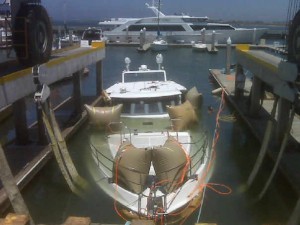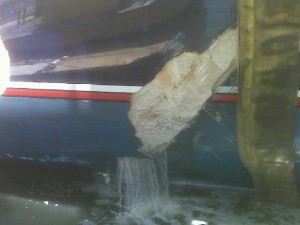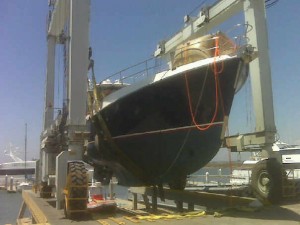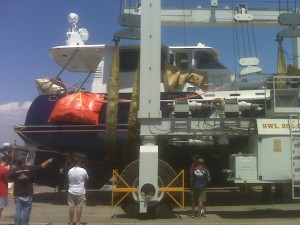TowBoatUS raises 56′ yacht after it was dropped off of a delivery ship
What should have been a basic delivery of a brand new yacht on Saturday turned into a wild experience and a wreck removal from the depths of San Diego Bay. Around 10:30 am on June 27, 2009 the “Vessel Assist Shelter Island” was on its way to the 10th Ave Terminal to pick up a crew from the pier and deliver them to a new yacht that was just shipped in. Robert Butler, President of Vessel Assist San Diego, received a call from the delivery crew saying that the yacht was adrift and that they needed to be brought directly to it. Robert immediately called Captain Eric Lamb and informed him that the boat was let loose before the delivery crew could get on board. The yacht, valued in excess of 1.5 million dollars, was adrift as the incoming tide was pushing it toward the Coronado Bridge.
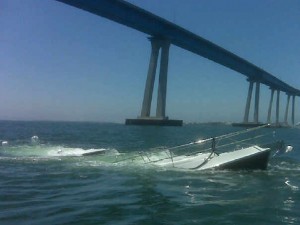
56' yacht sinks after being dropped from delivery ship
Captain Lamb, underway toward the shipping terminal, cranked the “Shelter Island” up to 31 knots hoping to get there before the yacht could hit the bridge or possibly another vessel. Soon after the first call the second call came in, the delivery crew said the boat was listing hard and might sink. Robert thought that perhaps an exhaust hose had not been connected at the factory and the boat may be taking on water. He was not informed that this vessel was actually dropped from the ship’s crane. Captain Lamb arrived on scene 8 minutes after the first call with pumps ready to go but the stern of the yacht was already underwater. Another Vessel Assist boat arrived on scene shortly after with additional pumps but there was no way to keep the boat afloat. Robert instructed his Captains to pull the yacht into shallow water and clear of the main channel. About 30 minutes after the yacht was dropped it sank in 35 feet of water just outside of the Naval security zone in front of Vessel Assist San Diego’s main facility.
Robert mobilized his crew and they immediately loaded salvage and haz-mat gear onto the “Vessel Assist Coronado”, the “Shelter Island”, and the “Harbor Island”. Captains Tony Olson, Travis Basom, and Shane Thompson were dispatched to dive on this job just as they were returning from a salvage they had performed in Marina Del Rey. A big issue when dealing with a salvage of this magnitude on a busy Saturday afternoon is having enough crew to perform the salvage while still tending to the rest of the Vessel Assist members needing assistance in the San Diego area (Vessel Assist was able to assist 17 other vessels and perform another salvage that same day).
The challenges with raising the new yacht were tough:
First, dry, the yacht weighed approximately 95,000lbs but after the sinking it was, obviously, full of water …so having enough float bags was critical.
Second, the yacht suffered enough damage to sink in under 30 minutes. This meant that the holes were significant in size possibly in number.
The strategy was to get the yacht to the surface using over 100,000 lbs of lift with float bags and tow it awash (partially submerged) to Marine Group Boat Yard to haul out. Keeping 14 float bags inflated for the 1 knot tow was crucial to the success of the operation.
As the divers attached float bags Vessel Assist’s riggers, Michael Greer and Tom Butler, rigged lines to bags and prepared the air hoses for the lift while Robert worked on the logistics of raising the 50ton yacht from the bottom of the bay. Another issue was that this 50 ton yacht sank into the sticky mud making the yacht even more difficult to raise. This phenomenon is commonly referred to as “mud sucked”. Additional flotation had to be used to overcome the grasp of the mud.
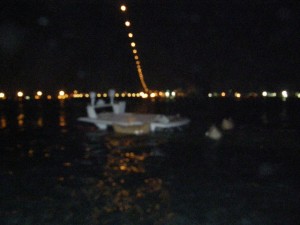
56' yacht raised in the darkness of night
The tow would have to be a race against the tide. 1.2 knots was the best speed they could make while towing the vessel with just the roof out of the water and 15′ of vessel underwater. Captain Eric Lamb had to skirt the right side of the channel just in case any of the lift bags blew out during the stressful tow. In all, five bags were lost but Robert had planned for loss and still had plenty of flotation when the boat arrived at the boatyard.
Once in the boatyard, Vessel Assist used three boats to maneuver the yacht, in tight quarters, to the Travelift. From there a forklift and man power were used to maneuver the yacht into position for the final. Because the tide had now turned they lost the very small window to get the yacht out of the water and would have to secure the vessel and wait until the Sunday when they could rig cables to pull the vessel up high enough to place lifting straps under the hull. On Sunday, after several hours of technical preparation, the lifting straps were put into position and the yacht was raised incrementally while Vessel Assist used pumps to remove as much water from the hull as possible during the hoist. Once the hull was raised completely out of the water the true damage to the yacht was visible as thousands of gallons of water poured out of the massive holes on the vessel.
Robert stated, “One bright note during this entire accident is that nobody was injured. It’s safe to say, this is one reason why a crew cannot be on a yacht while it is being off-loaded from the delivery vessel.”
______________________________________________________
